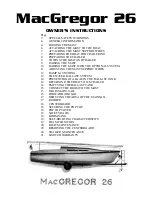
72
CAUTION:
Avoid watercraft opera-
tion in weeded areas. If unavoidable,
vary watercraft speed.
Rough Water or Poor
Visibility Operation
Avoid operation in these conditions. If
you must do so, proceed with caution
and prudence using minimum speed.
Crossing Waves
Reduce speed.
Always be prepared to steer and balance
as necessary.
When crossing wakes, always keep a
safe distance from
watercraft
ahead.
Stopping/Docking
The watercraft is slowed by water drag.
The stopping distance will vary depend-
ing on the watercraft size, weight,
speed, water surface condition, pres-
ence and direction of wind and current.
The operator should become familiar-
ized with the stopping distance under
different conditions.
Release the throttle at a sufficient dis-
tance before the expected landing area.
Reduce speed to idle.
On models equipped with shifter
system
, shift to neutral, reverse or for-
ward, as required.
Beaching
CAUTION:
It is not recommended to
run the watercraft to the beach.
Come slowly to the beach and shut off
the using the safety lanyard when wa-
ter depth is 90 cm (3 ft) under the hull,
then pull the watercraft to the beach.
WARNING
When crossing wakes, slow down.
Operator and passenger(s) can
brace themselves by posting. Do
not jump waves or wakes.
F01L50Y
WARNING
On models
without
O.P.A.S. direc-
tional control is reduced when the
throttle is released and lost when
engine is off.
WARNING
On models
with
O.P.A.S. direc-
tional control is reduced when the
throttle is released and/or when en-
gine is off.
F07A0EY
smo2002-002a.book Page 72 Monday, July 30, 2001 2:18 PM
www.SeaDooManuals.net
Summary of Contents for GS 2002
Page 1: ...www SeaDooManuals net ...
Page 132: ...www SeaDooManuals net ...
















































